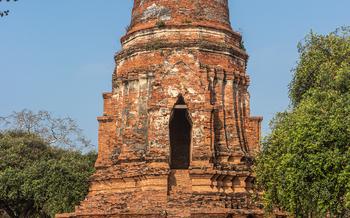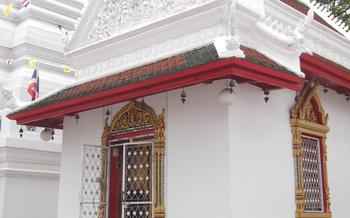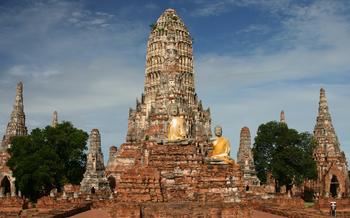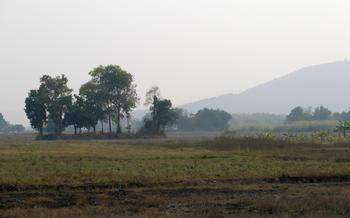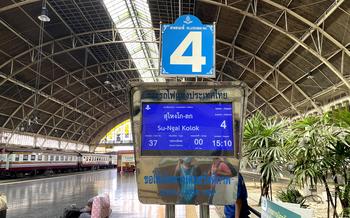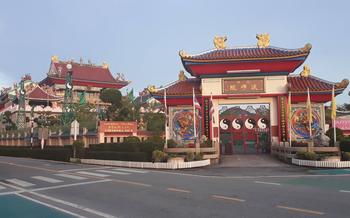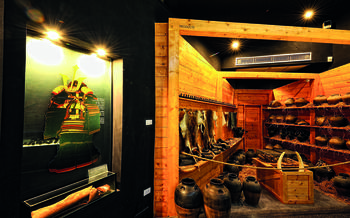
Wang Muang Cave
- Historical Significance
- Natural Beauty
- Exploring the Cave
- Guided Tours
- Accessibility and Transportation
- Accommodations Nearby
- Shopping and Souvenirs
- Other Nearby Attractions
- Cultural Etiquette and Customs
- Safety and Precautions
- Photography and Videography
- Sustainability and Conservation
- Insider Tip
Historical Significance
Wang Muang Cave holds immense historical significance as it served as a hideout for King Naresuan the Great during the 16th century. The cave provided refuge to the king and his loyal followers during times of war, enabling them to strategize and plan their battles against the Burmese invaders. In addition, the cave acted as a shelter for local villagers during wartime, offering protection from enemy forces. The cave's strategic location and natural fortifications made it an ideal hideout and a symbol of resistance against foreign aggression. Furthermore, the cave holds cultural and religious importance, as it is considered a sacred site by the local people. It is believed to be the dwelling place of spirits and deities, and visitors often pay homage and make offerings to seek blessings and protection.
Natural Beauty
The Wang Muang Cave is a testament to nature's artistry, showcasing a stunning array of limestone formations that have been sculpted over millions of years by the relentless forces of water and minerals. The cave's interior is adorned with intricate stalactites, delicate and graceful, hanging like chandeliers from the high ceiling. Their counterparts, stalagmites, rise from the cave floor, their tips reaching towards the stalactites in a dance of stone. The result is a mesmerizing display of natural architecture, creating a subterranean wonderland that leaves visitors in awe.
These formations come in a variety of shapes and sizes, each one unique and captivating. Some resemble towering pillars, others delicate curtains, and still others whimsical creatures frozen in time. The interplay of light and shadow further enhances the cave's beauty, casting dramatic silhouettes and revealing hidden details in the rock formations. The cave's walls shimmer and sparkle with mineral deposits, adding a touch of magic to the already enchanting atmosphere.
The Wang Muang Cave is also home to a diverse ecosystem, with a variety of flora and fauna thriving in and around its chambers. Visitors may encounter bats flitting through the darkness, their wings creating a soft rustling sound. The cave's walls provide a habitat for various insects, spiders, and other small creatures, each playing a vital role in the cave's delicate ecosystem. The surrounding forest is also home to a variety of plants and animals, creating a rich tapestry of life that adds to the cave's natural allure.
Exploring the Cave
To fully immerse yourself in the wonders of Wang Muang Cave, it's best to embark on a guided exploration. These tours, led by experienced local guides, provide valuable insights into the cave's history, geology, and diverse ecosystem. Guided tours typically last around an hour and cover the cave's main chambers and tunnels, allowing visitors to witness the stunning stalactites, stalagmites, and other rock formations up close.
As you delve deeper into the cave, marvel at the intricate limestone formations that have been shaped by water erosion over millions of years. Discover hidden chambers adorned with sparkling crystals and glistening rock pools, each offering a unique and awe-inspiring sight. The guides will point out notable features, explain the geological processes that created them, and share fascinating stories about the cave's history and cultural significance.
While exploring the cave, it's important to respect the natural environment and follow safety guidelines. Stick to designated trails, avoid touching or damaging the cave formations, and be mindful of your noise level to preserve the tranquility of the cave. Also, remember to bring a flashlight or headlamp, as some areas of the cave may be dimly lit. With proper precautions and a sense of wonder, exploring Wang Muang Cave promises an unforgettable adventure into the heart of Thailand's natural heritage.
Guided Tours
Exploring Wang Muang Cave with a knowledgeable and experienced guide is highly recommended. These guides offer invaluable insights into the cave's history, geology, and ecosystem, bringing the cave's wonders to life. They can point out hidden details, share fascinating stories, and answer any questions you may have.
Guided tours typically last between one and two hours, allowing ample time to explore the cave's various chambers and tunnels. Guides provide flashlights or headlamps to illuminate the cave's interior, ensuring a safe and enjoyable experience.
To book a guided tour, visitors can contact local tour operators or inquire at the cave's visitor center. Tours are available in various languages, including English, Thai, and Chinese. The cost of a guided tour varies depending on the group size and the duration of the tour.
By opting for a guided tour, visitors not only gain a deeper understanding of Wang Muang Cave but also contribute to the preservation of this natural and cultural treasure. Guides play a crucial role in ensuring the cave's sustainability by educating visitors about responsible tourism practices and promoting respect for the cave's environment.
Accessibility and Transportation
Wang Muang Cave is conveniently located in Saraburi province, around 100 kilometers northeast of Bangkok. Reaching the cave is relatively easy, with several transportation options available. For those driving from Bangkok, take Highway 1 and follow the signs to Saraburi. From there, take Highway 2 and continue until you reach the cave, which is well-marked with signs. Alternatively, public transportation is also an option. From Bangkok, take a bus to Saraburi and then transfer to a local bus or songthaew (shared taxi) to the cave. The journey takes approximately 2-3 hours by car and slightly longer by public transportation. Visitors can also opt for a guided tour, which often includes transportation from Bangkok or nearby cities, ensuring a hassle-free and informative journey to Wang Muang Cave.
Accommodations Nearby
For a comfortable and convenient stay near Wang Muang Cave, visitors have a range of accommodation options to choose from. Whether seeking budget-friendly guesthouses or luxurious resorts, there's something to suit every traveler's needs and preferences.
Just a short distance from the cave, visitors will find a selection of cozy guesthouses offering basic yet comfortable accommodations. These guesthouses often provide a homey atmosphere, allowing guests to interact with local families and experience Thai hospitality firsthand. For those seeking a more immersive experience, homestays in nearby villages offer a unique opportunity to live among the local community and learn about their way of life.
For travelers desiring a higher level of comfort and amenities, several mid-range hotels and resorts are located within easy reach of the cave. These establishments typically offer air-conditioned rooms, private bathrooms, and a range of facilities such as swimming pools, restaurants, and Wi-Fi.
For those seeking an unforgettable experience, a few exclusive luxury resorts are nestled amidst the stunning natural scenery surrounding the cave. These resorts offer guests the ultimate in comfort and indulgence, with spacious villas, private balconies overlooking breathtaking views, and a host of amenities designed to pamper and rejuvenate.
To ensure a hassle-free stay, visitors are advised to book their accommodations in advance, especially during peak tourist season. Online booking platforms and local tour operators can assist in finding the ideal accommodation that suits individual preferences and budgets.
Shopping and Souvenirs
Wang Muang Cave and its surroundings offer a variety of shopping opportunities for visitors to take home unique souvenirs and local products. The nearby markets, souvenir shops, and handicraft stores are a treasure trove of authentic Thai goods. From intricate handmade crafts and traditional textiles to local snacks and delicacies, there's something for every taste and budget.
One of the most popular souvenirs from the area is the Wang Muang Cave amulet. These amulets are believed to bring good luck, protection, and prosperity to their owners. They are often made of sacred metals or stones and are intricately carved with auspicious symbols. Visitors can find these amulets at many of the souvenir shops near the cave.
Another popular souvenir is the Wang Muang Cave T-shirt. These T-shirts are a great way to show off your visit to the cave and support local businesses. They are available in a variety of colors and designs, so you're sure to find one that fits your style.
If you're looking for something more unique, be sure to check out the local handicrafts. The villagers in the area are skilled artisans who create beautiful handmade products, such as pottery, woven baskets, and wood carvings. These handicrafts are not only beautiful but also sustainable, as they are made from natural materials and traditional techniques.
Shopping at the local markets is a great way to support the local economy and benefit the community. Visitors can find a variety of fresh produce, handmade goods, and local delicacies at these markets. Be sure to haggle for the best price and enjoy the vibrant atmosphere of these bustling marketplaces.
Other Nearby Attractions
In addition to the fascinating Wang Muang Cave, the Saraburi province offers a wealth of other attractions that visitors can explore. Just a short drive away is the Khao Yai National Park, a UNESCO World Heritage Site renowned for its stunning scenery, diverse wildlife, and cascading waterfalls. Visitors can embark on jungle trekking adventures, spot elephants and gibbons in their natural habitat, and camp under the stars.
For history buffs, the Ayutthaya Historical Park, a former capital of the Ayutthaya Kingdom, is a must-visit. Explore the ruins of ancient temples, palaces, and fortifications, and learn about the kingdom's rich history and cultural heritage.
Nature lovers can head to the Bung Chawak Wetlands, a vast freshwater marsh teeming with birdlife. Take a boat tour through the reeds, spot migratory birds from around the world, and immerse yourself in the tranquil beauty of this natural sanctuary.
Art enthusiasts will appreciate the Saraburi Art Center, showcasing contemporary Thai art exhibitions and workshops. Learn about local artists and their unique perspectives, and take home a piece of original artwork as a souvenir of your trip.
Cultural Etiquette and Customs
When visiting Wang Muang Cave, it is essential to be mindful of local customs and traditions to ensure a respectful and enjoyable experience. Visitors should dress modestly, covering their shoulders and knees, especially when entering the cave's sacred chambers. It is considered polite to remove one's shoes before entering the cave and to speak quietly to avoid disturbing the peaceful atmosphere. It is also important to refrain from touching or damaging any of the cave's natural formations, as they are considered sacred and hold religious significance. By observing local customs and showing respect for the cave's cultural and religious heritage, visitors can contribute to preserving its sanctity and ensuring a harmonious experience for all.
Safety and Precautions
Exploring Wang Muang Cave requires visitors to prioritize their safety. Sturdy and comfortable shoes are essential for navigating uneven terrain and slippery surfaces. A reliable flashlight or headlamp is a must-have to illuminate the cave's interior and avoid tripping hazards. Visitors should remain aware of their surroundings and maintain a safe distance from cave walls and formations to prevent accidental damage. It's important to respect the natural environment and avoid touching or disturbing the delicate cave formations. Additionally, visitors should be cautious of potential wildlife encounters, such as bats or insects, and avoid disturbing their habitat. By following these safety guidelines, visitors can ensure a safe and enjoyable experience while exploring the wonders of Wang Muang Cave.
Photography and Videography
Wang Muang Cave presents a photographer's paradise with its captivating natural formations, intricate details, and dramatic lighting. While capturing the cave's beauty is encouraged, visitors must adhere to the cave's photography and videography policies.
Photography and videography are generally permitted within the cave, but visitors should respect any designated areas where photography may be restricted for conservation or safety reasons. It's essential to avoid using flash photography, as it can damage the delicate cave formations and disturb the wildlife.
To capture stunning shots, bring a sturdy tripod and a wide-angle lens to capture the cave's vastness. Experiment with different shutter speeds and apertures to create dramatic effects, such as long exposure shots of flowing water or starbursts from the cave's openings.
For videographers, a stable camera mount or a gimbal is recommended to ensure smooth footage. Consider using a variety of shots, including wide-angle panoramas, close-ups of formations, and time-lapse sequences to showcase the cave's dynamic beauty.
Remember to respect the cave's natural environment and avoid disturbing other visitors by keeping your voice low and minimizing movement. By following these guidelines, you can capture beautiful memories of your Wang Muang Cave exploration while preserving its pristine beauty for future generations.
Sustainability and Conservation
As a responsible traveler, it's crucial to be mindful of your environmental impact when visiting Wang Muang Cave. The cave's delicate ecosystem is home to a diverse array of flora and fauna, and it's important to preserve its natural beauty for future generations. Here are some ways you can contribute to sustainable tourism practices:
-
Reduce Plastic Waste: Avoid bringing single-use plastic bags, bottles, or straws into the cave. Opt for reusable alternatives and properly dispose of any waste in designated bins.
-
Respect Wildlife: Refrain from disturbing or feeding the wildlife that resides in and around the cave. Observe animals from a distance and avoid any actions that may cause them stress or harm.
-
Stay on Designated Trails: Follow the marked trails within the cave to minimize your impact on the surrounding environment. Straying off the trails can damage fragile plant life and disrupt the cave's ecosystem.
-
Support Conservation Efforts: Consider donating to local conservation organizations or initiatives that work to protect the cave and its surroundings. Your contribution can help fund research, restoration projects, and educational programs aimed at preserving this natural wonder.
Insider Tip
For an unforgettable experience, visit Wang Muang Cave during the annual Loy Krathong festival, typically held in November. During this festival, locals release thousands of handmade floating lanterns into the sky, creating a magical display of lights that illuminates the cave's entrance. This unique event offers a rare opportunity to witness the cave's natural beauty in a new and enchanting light.
